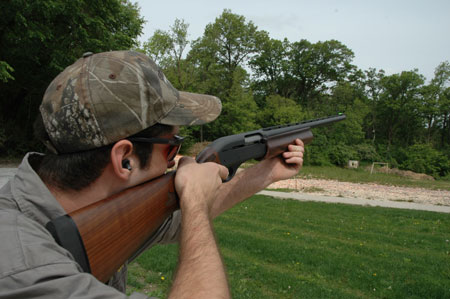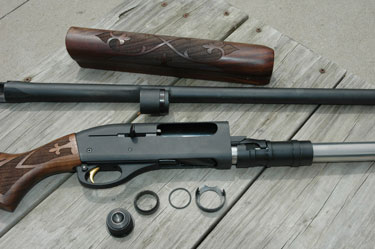 The Model 11-87 Sportsman Field shotgun is no cheap knock-off, but is designed with the wallet in mind. Available in 20 and 12 gauge, it sports many of the features that made the original Model 11-87 so great.
The Model 11-87 Sportsman Field shotgun is no cheap knock-off, but is designed with the wallet in mind. Available in 20 and 12 gauge, it sports many of the features that made the original Model 11-87 so great.
I BOUGHT MY first Remington Model 11-87 a year after the shotgun’s debut, which – perhaps not surprisingly – was in 1987. Mine was a purchase born out of necessity, or so I reasoned. I’d been invited to the Finger Lakes Region of central New York to hunt Canada geese, and didn’t, as the saying goes, have a thing to wear. Or in my case, a thing to shoot. A brief discussion with Rich Vance of Vance’s Sporting Goods in Columbus, Ohio, and a few dollars saved from a bartending gig, and I was headed home in the company of the familiar long cardboard box treasured by all shooters.
Today, my original M11-87 is semi-retired; however, over the course of its 22-year coast-to-coast life, it accounted for a tremendous variety of game, both furred and feathered, ranging from whitetails to grey fox to my first harlequin tagged on Washington state’s Birch Bay. Certainly, the piece looks its age – scars, scratches, dents, and wear – but then again, so too do I. That said, the autoloader has never once failed me, and that says a lot given the muck and mire and general abuse to which I oft-expose my firearms.
Recently, I had the opportunity to work with the M11-87s 21st Century cousin, a spin-off known simply as the M11-87 Sportsman Field. And while it’s true I did notice some, let’s call them, economical downgrades which set this version apart from its older brother, the Sportsman Field is definitely not a cheap knock-off; rather, a well-made – and actually quite nice-looking – piece designed with the wallet-watching ‘fowler or clays enthusiast in mind.
 Technically Speaking
Technically Speaking
Like the original M11-87, and the wildly-successful M1100 before it, the Sportsman Field is a gas-operated autoloader of, at least in my opinion, elemental design. Operational innards, i.e. the gas-regulating system for the 12-gauge model consists of a barrel-mounted gas cylinder and separate gas collar; a gas piston and barrel seal, also known as the familiar Remington O-ring, ride the magazine tube, and round out the assembly. It was interesting to note the 20-gauge version also included a thin-walled barrel seal activator in addition to the twin pistons and O-ring.
A second item of note is the 20-gauge’s skeletonized action bar assembly, the component which travels fore and aft on the magazine tube, and upon which the bolt rides. I’m assuming the change was not prompted by cosmetics, as the muzzle-most portion of the assembly is encased, and thus concealed, by the forearm.
Aesthetically, as well as operationally, the Sportsman Field remains, for the most part, Old School M11-87. Checkered American walnut, matte finish, twin beads, ventilated rib, simple one-piece two-pin trigger group, cross-bolt safety – this really is your father’s M11-87, with the exception of a gold-plated trigger and a nickel-plated bolt. Both of these upgrades, I’ll call them, are purely visual; an effort to psychologically transform a mid-priced autoloader into something slightly more upper crust, perhaps.
Barrel length options are 28 inches for the 12-bore, and 26 for the 20-gauge. Both feature 3-inch chambers, and both come packaged with a single choke tube, which in this case is modified. Both models, too, sport Remington’s ‘R’ logo laser-engraved on the pistol grip cap.
My Personal Report Card
Overall, my only less-than-positive comments about the Sportsman Field either are related to cosmetics or have to do, I’m sure, with the company’s goal to produce a reliable yet affordable shotgun; a note which then translates directly back to the aforementioned cosmetic factor. For example, while I would imagine the nickel-plated bolt lends somewhat to corrosion-resistance, the golden trigger is but gingerbread on an otherwise relatively utilitarian firearm, and as such, seems slightly out of place.
Sling swivels are absent, as perhaps they should be on a piece of this nature and price point – NOTE: New-in-box firearms can be found online from $600 to $660 – as is the traditional slotted recoil pad, both elements I do enjoy having. And yes, it’s nitpicky and has everything to do with visuals, but I do miss the M1100’s white diamond inset on the underside of the pistol grip. Call me sentimental, if you wish.
To break from the discussion on aesthetics, I have experienced two mechanical problems, perse, with my M11-87s during the time I’ve owned them. On three or four different occasions, the feed latch, a long flat piece located on the inboard ejection port side of the receiver responsible for holding rounds inside the magazine tube, on my 1988 model has detached while in use afield.
While not rendering the shotgun inoperable, it does effectively transform an autoloader into a single shot – and that’s a somewhat frustrating situation when the mallards are on the move. The second situation involved my wife’s M11-87 (1994) and a broken breech bolt buffer, the hard plastic sleeve encasing the rearward portion of the firing. This I attributed, albeit unscientifically, to my installation of a Sure Cycle System in this particular piece, and the subsequent increased impact force imparted on the rear of the bolt upon firing. In the first instance, the feed latch was reinstalled by a local gunsmith; the broken bolt, on the other hand, was quickly replaced, no questions asked, by the folks at Remington.
Positively speaking, the Sportsman Field offers plenty. Internally, the switch from a two-piece piston seal assembly to a one-piece unit in the 12-gauge model does, to me, make a certain amount of sense from both a routine maintenance, as well as a design standpoint. Remington, in the case of the M11-87, has done an excellent of keeping their firearms internally simple. By my count, a good cleaning requires the removal of but two parts – gas cylinder collar, and piston seal assembly – excluding the barrel and O-ring. An end-of-year wash increases this parts count by six; however, the gun is now as naked as it need be, with the task of reassembly taking not more than a couple minutes.
For more than two decades and after having digested thousands of rounds, my M11-87s have performed admirably. Minor mechanical glitches aside, the shotguns have proved themselves exceptionally reliable through all types of conditions and environmental situations, including repeated exposure to saltwater. I have no reason to doubt this new version, the Sportsman Field, will handle itself – and anything that flies, flushes, or is thrown before its muzzle – just as well.
Model 11-87 Sportsman Field Specs
Action – Semi-automatic; gas-operated
Gauge – 3” 20- and 12-gauge
Length – 48”
Weight – 8.4 pounds (12-gauge); 6.13 pounds (20-gauge)
Trigger – 4.15 pounds (average of three)
Sights – Traditional (silver) front bead – small mid-bead
Barrel on model tested – 28”
Stock – American walnut; 13.5”
Finish – Flat matte
Choke – Interchangeable Rem-
Choke system
Recoil pad – .875” solid rubber
This article appeared in the July 5, 2010 issue of Gun Digest the Magazine.

Next Step: Get your FREE Printable Target Pack
Enhance your shooting precision with our 62 MOA Targets, perfect for rifles and handguns. Crafted in collaboration with Storm Tactical for accuracy and versatility.
Subscribe to the Gun Digest email newsletter and get your downloadable target pack sent straight to your inbox. Stay updated with the latest firearms info in the industry.

![Best Concealed Carry Guns In 2025 [Field Tested] Wilson Combat EDC X9S 1](https://gundigest.com/wp-content/uploads/Wilson-Combat-EDC-X9S-1-324x160.jpg)


![Best 9mm Carbine: Affordable PCCs [Tested] Ruger Carbine Shooting](https://gundigest.com/wp-content/uploads/Ruger-Carbine-Shooting-100x70.jpg)
![Best AR-15: Top Options Available Today [Field Tested] Harrington and Richardson PSA XM177E2 feature](https://gundigest.com/wp-content/uploads/Harrington-and-Richardson-PSA-XM177E2-feature-100x70.jpg)

How is it possible for the feed latch to come out while out in the field? If I understand correctly that’s the flat piece of metal that’s staked in place inside the receiver and held in position by the trigger pin.